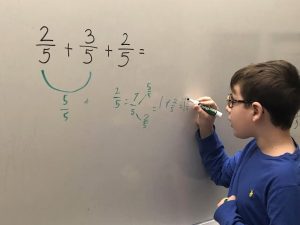By Jeanne Lott, Math Department Chair

This student has moved beyond the basic fundamentals and is now able to add the fifths and continue to compose and decompose fractional numbers until arriving at a final solution. He has not been taught any traditional rules or algorithms; yet is able to solve a multi-step problem based on his conceptual knowledge.
Stephen Gaynor School’s math curriculum is based on the three-pronged Singapore Math approach which includes concrete (hands-on), pictorial (visuals), and abstract (symbolism). No area of elementary mathematics is as mathematically rich, cognitively complicated, and difficult to teach as fractions, ratios, and proportionality.
Fractions are notoriously known to be little more than memorizing computational procedures and algorithms. Yet, an understanding of the interconnected concepts of multiplication, division, fractions, ratios, proportions, and linear functions is central to success in algebra.
At Gaynor, the way students learn about fractions has been transformed from an experience of memorization of rules (the way most of us adults learned) to one filled with concrete manipulative materials showing unit fractions, pictorial representations of equal parts, and significant math discourse to connect whole numbers and fractional parts. Understanding fractions as numbers that are used for naming quantities is critical before abstract representation is introduced.
Dr. Yeap Ban Har reminds us that one of the fundamental ideas in mathematics is that only like terms can be combined. By simplifying that language for our young students and referring to the terms as nouns, students are able to understand that like nouns can be combined. When fractional parts are explained as one fifth, for example, using words rather than abstract symbols, students easily combine all the fifths because each fifth represents the same size piece, or like nouns, or like terms. Two fifths and two more fifths simply make four fifths.
Our goal is to foster an understanding of underlying concepts as we continue to connect the marvelous world of mathematics for each of our students.
This student has moved beyond the basic fundamentals and is now able to add the fifths and continue to compose and decompose fractional numbers until arriving at a final solution. He has not been taught any traditional rules or algorithms; yet is able to solve a multi-step problem based on his conceptual knowledge.
Source: John P. Smith III (2002, p. 3) ERIC Number: ED474726. Record Type: RIE
The Development of Students’ Knowledge of Fractions and Ratios. Publication Date: 2002
